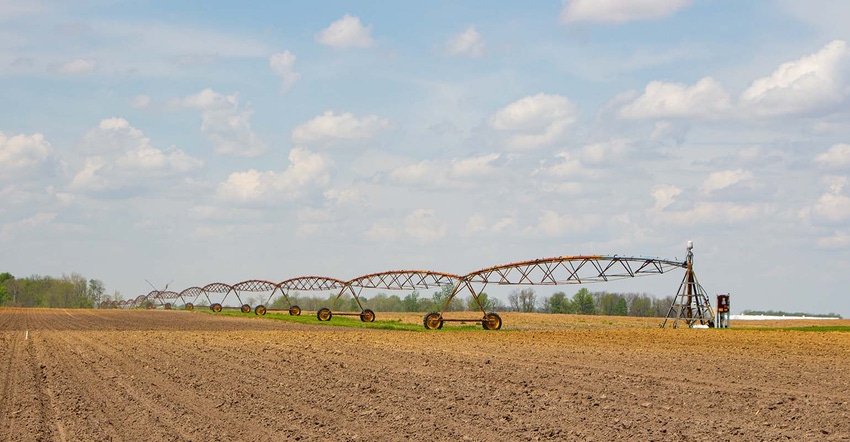July 1, 2022

Sponsored Content
Across the Cornbelt, with very few exceptions, water availability to the growing crop is a daily topic of conversation, consideration, or concern. Too much, too little, too late, and on occasion, there has even been concern of too dry to plant. We manage water with ditches, tile, subsurface drains, pipes, pumps, and supplemental irrigation water – the most common being an overhead, center pivot irrigation. And as goes water availability, so goes root growth and, in general, nutrient availability, especially nitrogen and sulfur. To a grower with sandy or coarse soils, the ability to irrigate is the ability to raise a profitable crop.
Irrigation water management (IWM) is both an art and a science. It requires a thorough understanding of the physical, biological, and chemical sciences and a strong dose of both intuition and experience.
Focusing on scheduling irrigation (supplemental water) to the growing crop is not a new concept but continues to be an elusive management practice for growers across the region. There are many tools, instruments, and models for growers to use to plan and monitor their irrigation events. Mother Nature and inconsistent precipitation are the greatest impediments to farmers’ most efficient management.

For all growers, understanding the water balance at the field level (Figure 1.) is important to managing crop growth/yield potential. The water balance starts with measuring (better than estimating) the soil water holding capacity in the effective rooting zone = available water capacity. This can vary from 2 to 10 in. of soil water in the top two feet of the soil profile.
The goal of irrigation is to maintain water in the soil between field capacity and an irrigation cycle above the permanent wilting point - science. The art of IWM is the function of weather forecasting and equipment maintenance and operation.
Referencing Figure 2. below on water holding capacity, at field capacity (FC), the soil is wet and contains all the water it can hold against gravity – a full sponge that doesn’t drip. At the “Permanent Wilting Point” (PWP), the soil is dry to the point that the plant can no longer extract any more water.
Figure 3. shows the general relationship between soil moisture, available water, and soil texture. In general, the finer the soil texture, the greater the total water holding capacity. However, as clay content increases, the water available to the plant decreases proportionately as the clay particles hold the water molecule tightly.
Knowing the available water [FC – PWP] to the growing crop is the starting point in irrigation scheduling regardless of the method/model by which you balance. The simplest method is known as the checkbook method*. As with managing a bank account, available water in the rooting zone is your starting balance. Evaporation (from soil, residue, crop) and transpiration (crop) are your debits. Precipitation and irrigation are your credits. Managing the “checkbook” is a daily activity. There are numerous resources available to schedule, including phone apps provided by irrigation system manufacturers like Valley, and Zimmatic.
In an ideal situation, supplemental water would be scheduled so that the next irrigation would increase the available water balance but not above the total water holding capacity of the soil. An ideal situation turns south when an unexpected rain pushes the soil profile to the saturation point, which can compound root growth and then ensuing water stresses. As seasoned irrigators often share, the easiest growing seasons to manage the water balance are when it does not rain.
Although the checkbook method is time tested, having a better understanding of real-time soil moisture values in the active rooting zone increases your accuracy and efficiency. Soil moisture sensors/ probes in the root zone provide you with a calculated measurement of available soil water. With multiple sensors at different depths, you can better identify where the active root zone is located, as that is the depth at which the crop’s roots are removing moisture from the soil. Early in the growing season or in a wet year, reduced rooting depth is your correction to the models.
I recently participated in an Irrigators Certification Program and was reminded of the most valuable “instrument” (multiple is better) a grower can have at each irrigated field – a rain gauge or weather station. The absence of rain and/or collection devices at each irrigated field complicates the accuracy of managing water. Although there have been improvements in radar estimated precipitation and interpreted data from nearest weather stations, it is too often insufficient to provide the best management.
Growers that are irrigating or interested in implementing irrigation on their farms should look to their respective state University Extension Service. The U.S.A.- based Irrigation Association and affiliate organizations provide a central resource for irrigators. For next-generation instrumentation, check out the probes from CropMetrics™, an irrigation optimization company. If you have any questions about irrigation water management, please feel free to reach out to your local Beck’s representative.
Beck's - Farmers At Heart® - revolutionized the customer seed buying experience by remaining true to a foundation built on faith, family, and farming. Founded in 1937, Beck's appreciates the farmers who have helped them become the largest family-owned retail seed company and the third largest seed brand in the United States. The Beck family is now in its fifth generation of family members who work in the business to honor God and help farmers succeed. The Beck family and team of employees help farmers achieve success from generation to generation through authentic customer experiences, product diversity, seed quality, and performance. With a home office located in Atlanta, Ind., Beck's serves farmers throughout the Midwest and Mid-South. For more information about Beck's Superior Hybrids, Inc., visit www.beckshybrids.com.
About the Author(s)
You May Also Like




